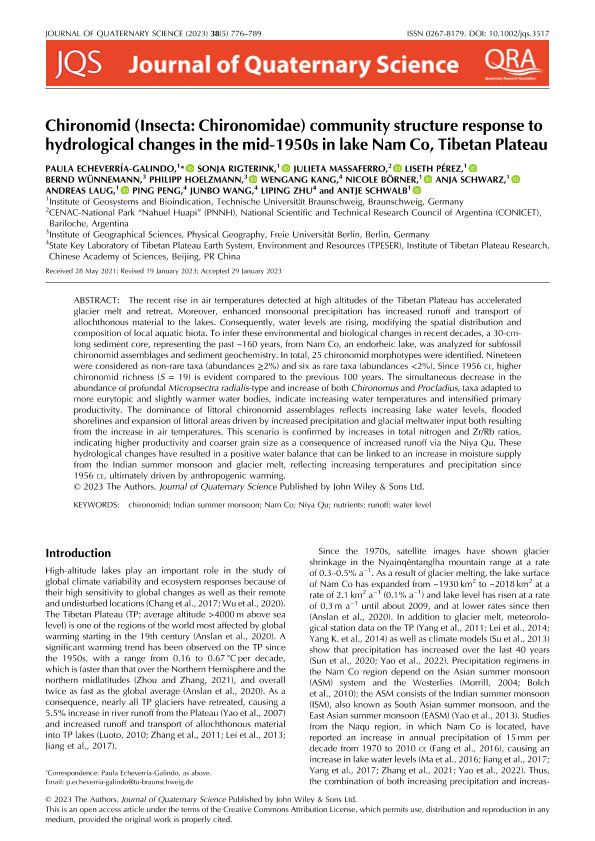Artículo
Chironomid (Insecta: Chironomidae) community structure response to hydrological changes in the mid-1950s in lake Nam Co, Tibetan Plateau
Echeverría Galindo, Paula; Rigterink, Sonja; Massaferro, Julieta ; Pérez, Liseth; Wünnemann, Bernd; Hoelzmann, Philipp; Kang, Wengang; Börner, Nicole; Schwarz, Anja; Laug, Andreas; Peng, Ping; Wang, Junbo; Zhu, Liping; Schwalb, Antje
; Pérez, Liseth; Wünnemann, Bernd; Hoelzmann, Philipp; Kang, Wengang; Börner, Nicole; Schwarz, Anja; Laug, Andreas; Peng, Ping; Wang, Junbo; Zhu, Liping; Schwalb, Antje
 ; Pérez, Liseth; Wünnemann, Bernd; Hoelzmann, Philipp; Kang, Wengang; Börner, Nicole; Schwarz, Anja; Laug, Andreas; Peng, Ping; Wang, Junbo; Zhu, Liping; Schwalb, Antje
; Pérez, Liseth; Wünnemann, Bernd; Hoelzmann, Philipp; Kang, Wengang; Börner, Nicole; Schwarz, Anja; Laug, Andreas; Peng, Ping; Wang, Junbo; Zhu, Liping; Schwalb, Antje
Fecha de publicación:
07/2023
Editorial:
John Wiley & Sons Ltd
Revista:
Journal Of Quaternary Science
ISSN:
0267-8179
Idioma:
Inglés
Tipo de recurso:
Artículo publicado
Clasificación temática:
Resumen
The recent rise in air temperatures detected at high altitudes of the Tibetan Plateau has accelerated glacier melt and retreat. Moreover, enhanced monsoonal precipitation has increased runoff and transport of allochthonous material to the lakes. Consequently, water levels are rising, modifying the spatial distribution and composition of local aquatic biota. To infer these environmental and biological changes in recent decades, a 30-cm-long sediment core, representing the past ~160 years, from Nam Co, an endorheic lake, was analyzed for subfossil chironomid assemblages and sediment geochemistry. In total, 25 chironomid morphotypes were identified. Nineteen were considered as non-rare taxa (abundances ≥2%) and six as rare taxa (abundances <2%). Since 1956 ce, higher chironomid richness (S = 19) is evident compared to the previous 100 years. The simultaneous decrease in the abundance of profundal Micropsectra radialis-type and increase of both Chironomus and Procladius, taxa adapted to more eurytopic and slightly warmer water bodies, indicate increasing water temperatures and intensified primary productivity. The dominance of littoral chironomid assemblages reflects increasing lake water levels, flooded shorelines and expansion of littoral areas driven by increased precipitation and glacial meltwater input both resulting from the increase in air temperatures. This scenario is confirmed by increases in total nitrogen and Zr/Rb ratios, indicating higher productivity and coarser grain size as a consequence of increased runoff via the Niya Qu. These hydrological changes have resulted in a positive water balance that can be linked to an increase in moisture supply from the Indian summer monsoon and glacier melt, reflecting increasing temperatures and precipitation since 1956 ce, ultimately driven by anthropogenic warming.
Palabras clave:
CHIRONOMID
,
INDIAN SUMMER MONSOON
,
NAM CO
,
NIYA QU
,
NUTRIENTS
,
RUNOFF
,
WATER LEVEL
Archivos asociados
Licencia
Identificadores
Colecciones
Articulos(CCT - PATAGONIA NORTE)
Articulos de CTRO.CIENTIFICO TECNOL.CONICET - PATAGONIA NORTE
Articulos de CTRO.CIENTIFICO TECNOL.CONICET - PATAGONIA NORTE
Citación
Echeverría Galindo, Paula; Rigterink, Sonja; Massaferro, Julieta; Pérez, Liseth; Wünnemann, Bernd; et al.; Chironomid (Insecta: Chironomidae) community structure response to hydrological changes in the mid-1950s in lake Nam Co, Tibetan Plateau; John Wiley & Sons Ltd; Journal Of Quaternary Science; 38; 5; 7-2023; 776-789
Compartir
Altmétricas



